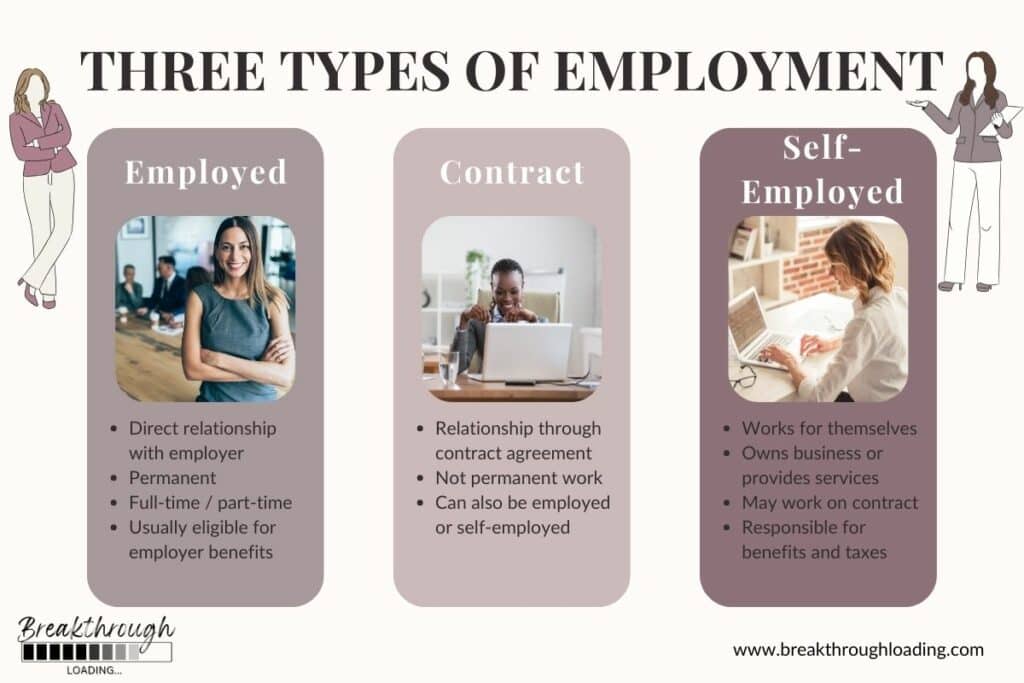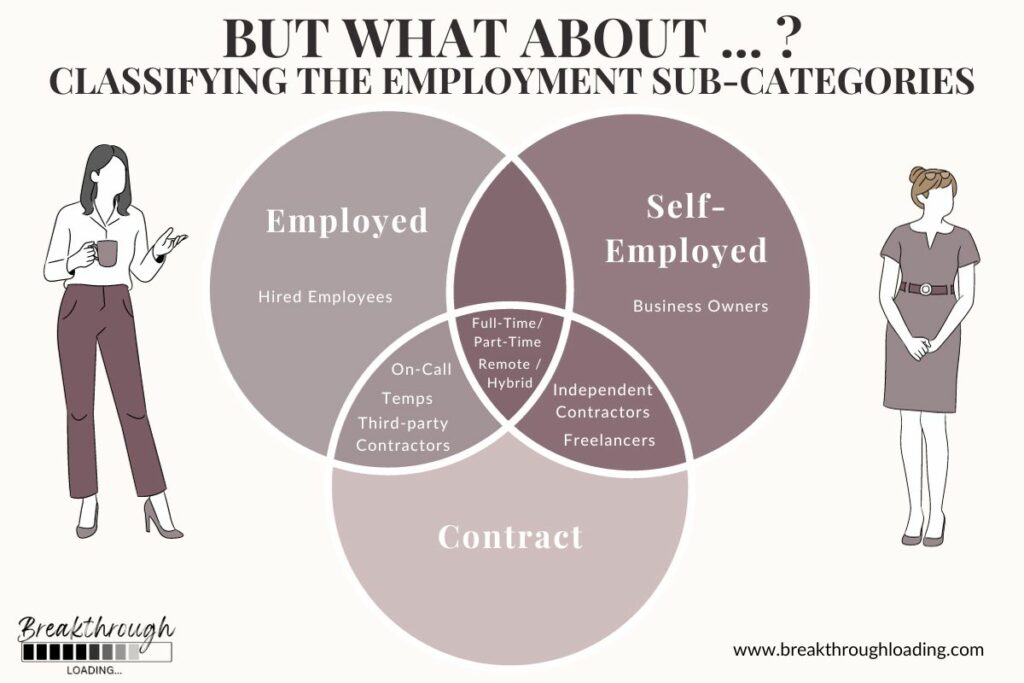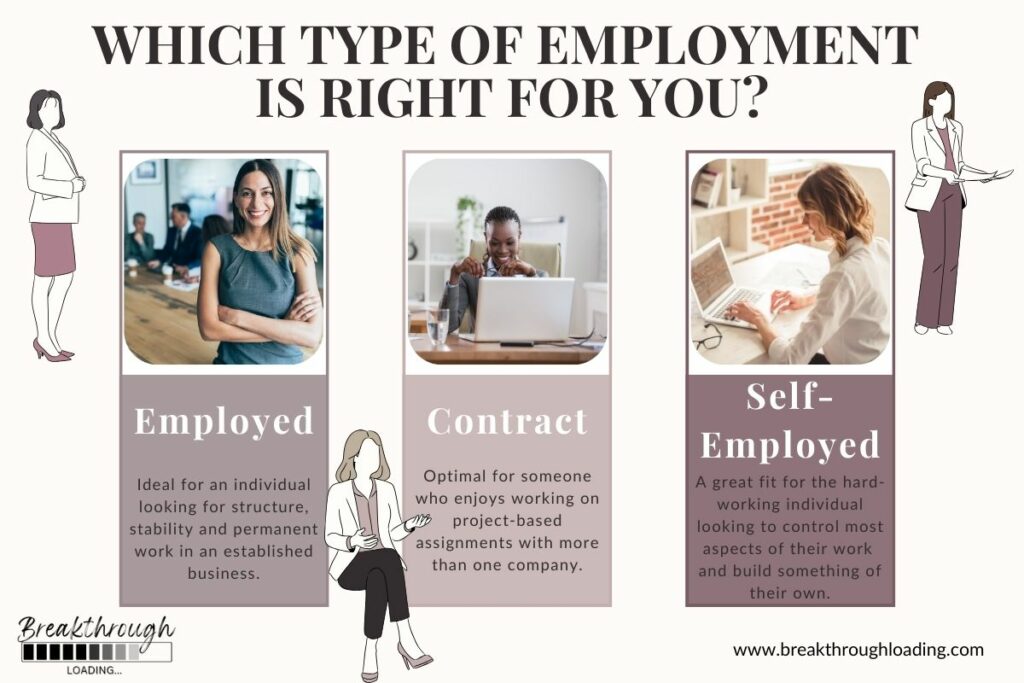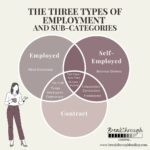The 3 different types of employment: which one is right for you?
Did you know there are three different types of employment? Long gone are the days when having a job meant going to the workplace, performing your job, and getting paid every other week. (Thank goodness —we needed to mix that up a bit!)
The dynamics of the workforce have been evolving since the beginning of time —from the prehistoric hunter-gatherer labor to the feudal system of the Middle Ages to the complex infrastructure of the modern day. And thanks to the technological advances of personal computers and the Internet, we are no longer held to the old-school standards of what we do, where we are, or how we work.

The results of Deloitte’s recent 2023 Global human capital trend report indicate that not only are we redefining what it means to work today, but our entire mindset around how we work must adapt to keep up with the changes. From the abundance of flexible work with contractors like Uber and DoorDash to the influx of self-employed social media influencers to the increase in remote work and the digital nomad life, the workforce looks drastically different than it did even a decade ago.
With all these changes and new options, perhaps now is a great time to refamiliarize yourself with what types of employment are available to you. You never know; you might just be intrigued to try a different way of working.
What are the three main types of employment?
While there are many variations and combinations of employment statuses, let’s break our workforce types into three main categories:

1. Employed
An employed individual has an employment contract with a business (aka the employer) to perform a specific role in exchange for a specified payment. This type of employment is considered permanent, as this agreement will continue until either the employee or employer chooses to terminate the working relationship.
The employed worker may work full-time (30+ hours per week) or part-time (generally less than 30 hours per week). They are usually eligible for additional employer benefits, such as health insurance and paid time off. The employer is also typically responsible for providing work equipment, performing time management, and paying payroll taxes.
Employed workers can work for either a public corporation or a private business.
2. Contract
A contract employee also has an agreement with the company to perform a particular function or task in exchange for a specified payment. However, unlike an employed worker, a contract worker can set their own payment rates and choose their own assignments. Contract arrangements are usually for a set amount of time or project-based; therefore, they are not considered permanent employment.
Similar to the employed worker, a contract employee may work full-time or part-time. However, contract employees are usually not eligible for additional employer benefits due to the impermanent nature of their position. The employer is also generally not responsible for providing work equipment, time management, and covering payroll taxes.
Contract workers can work through a contract agency or as independent contractors (freelancers).
3. Self-Employed
An individual is considered self-employed when they work solely for themselves and not for a specific company or individual. Someone who is self-employed may provide consulting or freelance services to a company or individual on a contract basis, or they may own and operate their own business. The primary distinction is that self-employed individuals are 100% liable for securing and performing their work (without oversight from a company or boss).
While a self-employed person is free to set their own rates and choose their work, they are also solely responsible for ensuring they have clients to work with. They must purchase their equipment and supplies, complete or outsource any applicable reporting, and pay their own taxes.

But what about …? (The employment sub-categories)
Regarding employment categories, there is a lot of gray area and overlap between classifications —which makes it all very confusing!
Here are just a few examples of employment sub-categories:
Temporary or Seasonal employees
Temporary (also called temps) and seasonal employees are exactly what they sound like —workers filling a temporary need. Seasonal staff may include positions like summertime lifeguards at your local pool or cashiers at a store during the busy holiday season. Temp employees may help fill a staff shortage in a business while a permanent employee is on leave or provide additional manpower during a special project.
Temporary and seasonal employees may be employed or contract employees and can work full-time or part-time, depending on the specific arrangement.
Third-party contractors
A third-party contractor may hire employees to provide services to another company through a contract agreement. This is a common practice in specialized consulting services, such as accounting and legal firms.
A great example would be a large corporation outsourcing its financial audits to a third-party contractor. The contractor hires a team of employed accountants who perform the audit services for the corporation but are not employed by the corporation.
Self-employed contractors
A self-employed contractor runs their own service business and works through contracts. The types of services can vary widely, from specialists such as electricians and plumbers to Uber drivers to virtual assistants.
Remote (Work at Home) and Hybrid workers
While we saw an increase in the remote workforce with the pandemic, the prevalence of work-from-home employees has been around for quite some time. Many self-employed individuals work from home or on the go, and many businesses enjoy saving space (and money) by engaging a remote workforce.
In addition, many companies now encourage a hybrid workplace approach of in-office and work-at-home. Hybrid workers can enjoy the flexibility of working remotely while maintaining in-person connections within the workplace.
Why does your employment type matter?
Does it matter what type of employment classification you fall into? Well, yes and no.
The primary reason your employment type matters is to ensure that government standards protect your employment as applicable. (You can read about the United States Fair Labor Standards Act here.) In addition, it is essential to understand if you are eligible for certain benefits through your employer and whether or not you are responsible for paying certain taxes.
Outside of understanding your employment rights and obligations, it is important to remember that there is no right or wrong way to be employed. What really matters is understanding what options you have and finding the best fit for yourself. There are so many ways to make a living today, allowing you to pick and choose your ideal working arrangement to suit your lifestyle and financial goals.
Enjoying this article? Check out one of these reads next!
The pros and cons of each employment type
How do you know which type of employment is right for you? Here are some of the pros and cons* for each employment type to consider as you evaluate your options.

1. Employed
Ideal for an individual looking for structure, stability, and permanent work in an established business.
Pros
- Clear roles and responsibilities
- Stable paycheck and employer-provided benefits
- Employer pays payroll taxes
- You are not solely responsible for making big decisions
- Company-provided opportunities for professional development and networking
Cons
- The employer controls work assignments, environment, and hours
- You may not get a vote in making certain business decisions that impact your work
- Internal business politics may result in inefficiency or frustration
2. Contract
Optimal for someone who enjoys working on project-based assignments with more than one company.
Pros
- Roles and responsibilities are defined within the contract
- Can define rates and negotiate work environment
- You are not solely responsible for making big decisions
Cons
- Do not have guaranteed work or income without clients
- May be responsible for your own benefits & paying taxes
- You may not get a vote in making certain business decisions that impact your work
- Must seek opportunities for professional development and networking
3. Self-Employed
A great fit for the hard-working individual looking to control most aspects of their work and build something of their own.
Pros
- Ability to pick and choose all work and clients
- Have ultimate flexibility to define rates and work environment
- Have 100% control over making decisions and driving business strategy
Cons
- May take a lot of time and up-front effort to achieve professional and financial goals
- Do not have guaranteed work or income without clients
- Responsible for your benefits & taxes
- Hold 100% responsibility for making decisions and driving business strategy
- Must seek opportunities for professional development and networking
What all employment types have in common
Throughout my personal career journey and while preparing this article, it was enlightening to realize that the most fundamental concerns of any career exist regardless of employment type.
Here are a few workforce conundrums you will face, no matter where or who you work for.
Every type of work comes with some risk
Just as a freelancer is not guaranteed to land that client or get that contract, an employee may also be furloughed or terminated at any time. Nothing is ever truly risk-free.
There is no such thing as the perfect job
No matter what you do or who you work for (even yourself!), you will inevitably encounter challenges and must do things you don’t want to. That is part of the reason you are getting paid to do the work!
Certain aspects of business are always important
Some things in business will (and should) always be important, such as building relationships, staying up-to-date on training and credentials, and maintaining a professional reputation.
The only constant (in life and business) is change
People come and go. Laws and rules evolve. Jobs and roles expand. Mindsets and priorities shift. The sooner you learn to accept this instead of fighting it, the better prepared you will be to navigate the changes successfully.
Redefining my ideal type of employment
Through my experiences growing up, I had always believed that full-time employed work was the safest and best type of employment. So, when I finished college and set out to make a career for myself, there was no question in my mind that I was destined to be a corporate employee.
However, after many years and changes in my personal life, I found that my priorities in my career had shifted. I had witnessed multiple layoffs, was burnt out navigating the frustrating corporate politics, and was starting to hear an internal call to create something of my own. It finally dawned on me that my corporate job might not be the best fit for me anymore.
So, I embraced my change of heart, packed up my two decades’ worth of business experience, and set off in a new professional direction.

Which type of employment is right for you?
Although I’ve done my best to lay out the many considerations of the various types of employment in this article for you, the truth is there will never be a quick and easy guide to finding your perfect career. That amazing job that looks great on paper may not be all it’s cracked up to be once you get in the role. What works for you now may or may not be the right fit in one or five or ten years. As the workforce dynamic continues to adapt and change, it is crucial to keep your eyes open and in tune to the changing landscape. By staying aware, you’ll be more open to seeing the new opportunities that pop up when you are ready to make a change.
*Note — These are just a few of the pros and cons of each employment type and this list should not be considered comprehensive. Every job, no matter what type, has unique aspects and should be evaluated individually. Back to reading
What kinds of employment have you held in your life? Has your perception of the kind of work you enjoy changed over the years? Share with us in the comments!






Thank you for such a thorough and wonderful article! I find for myself, I like the idea of regular employment with a hybrid model. I cannot be home every single day but being in the office each day is just not particularly necessary anymore.
I think the hybrid model is the way of the future Rob! It’s wonderful to have that face-to-face time with the flexibility of working from home. Thanks for the note!
Very interesting post on the different types of employment. My current situation is a full time employment – in person 5-6 days a week. I would love to explore different options in the very near future.
I’d encourage you to look at other options down the road, Debbie! The more professional experience you gain, the more skills you have to make a smooth transition when you’re ready. Thanks for reading!